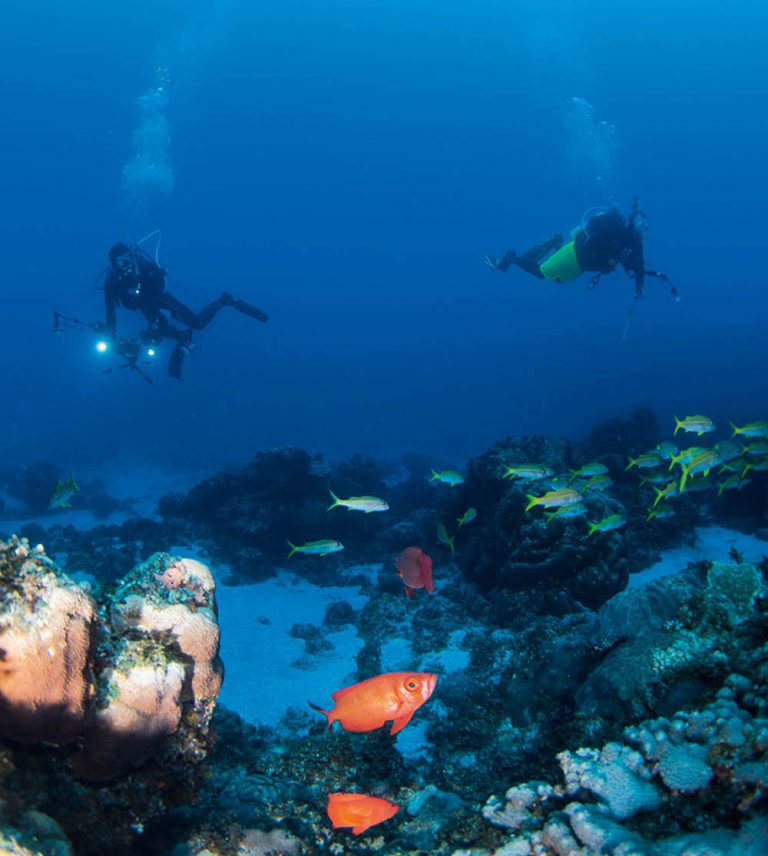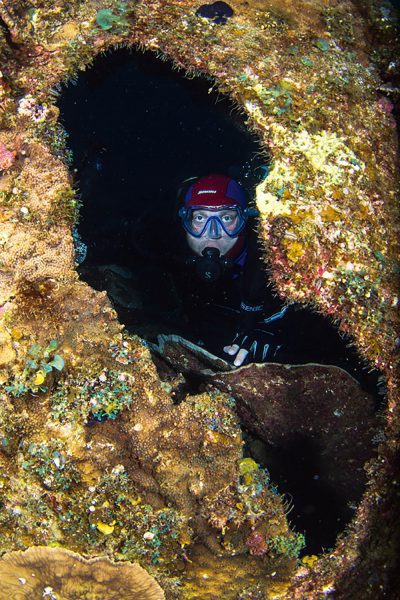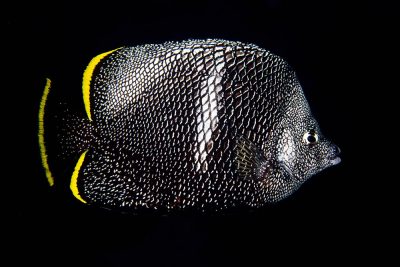Rum, Reefs & Wrecks
When your heart is set on visiting a hard-to-access destination, you have to hope that the diving infrastructure is up to the job. LISA COLLINS visits the Bonin Islands, but as cultural differences become apparent, divers start to go their separate ways…
ON WET, WINTRY SUNDAYS, it’s a habit of mine to pull up Google Maps on my computer and try to find unusual or out-of-the-way places to go diving. I love diving anywhere, but it appeals to my adventurous side to visit islands in the middle of nowhere.
We were due to travel to Tokyo to visit a Japanese friend, Takuya, and dive with him in the Izu Peninsula, a couple of hours from the city. Looking at the satellite view of where we were going, I expanded the map and found a few tiny islands clustered together in mid-Pacific.
Zooming in, I found an English name – the Bonin Islands. Intrigued, I did a search, and what I found made me long to dive there.
They are known locally as the Ogasawara Islands, named by a Samurai who claimed that his ancestor Ogasawara Sadoyon had discovered them in 1593. The British claimed possession in 1827, became the first settlers and gave them their Bonin name (from an old Japanese word for “unpopulated”).
Eight months later, after a 26-hour ferry ride from Tokyo on the 1000-passenger ferry Ogasawara Maru, we approached a Jurassic-like island.
Jagged jungle-covered peaks rose from a heavy mist, surrounded by the deepest blue ocean and the occasional blindingly white-sand cove. Expecting to see a 15m-tall gorilla hanging onto a cliff or pterodactyls flying at us out of the mist, we spotted no sign of habitation until, rounding a headland, a small town appeared.
Takuya had joined us on our adventure, along with two other friends living in Indonesia, Ana and Miguel. Although none of us had heard of the islands before, they turned out to have Tokyo postcodes, despite being more than 600 miles south of that city.
There are no airports on the islands, and only a Japanese naval helicopter available for emergencies – even then, it’s an almost six-hour flight to the nearest airport.
The Ogasawara plies the route between Tokyo and the main island of Chichijima (Father Island) every 5-6 days, which means a trip of two nights on the ferry and either three or 10 days on the island. We could stay only for the shorter duration, so had to make it count.
We had searched online for resorts with dive-centres where English was spoken. There were few, but we chose the small Urashiman, which also had five Western-style bedrooms, rather than the larger tourist hotel. This was because it offered diving to a remote site near the Keita Islands called Tuna Hole, known for schooling tuna and sharks.
Meeting us at the dock with his van, Urashiman’s owner Pandanus drove us the short way to the dive centre. We unpacked in the basic but very comfortable and spacious rooms and had a quick lunch in one of the many good restaurants that line the seafront and street behind it.
Then we reloaded our dive-gear in the van for the short journey to Urashiman’s large and well-equipped dive-boat.
OUR CHECK DIVE was at Ooiwa (Big Rock), a 20-minute boat-ride from the marina. Pandanus spoke little English but Takuya translated for a more in-depth briefing. This was slightly disconcerting at first, but it was extremely thorough.
There was one local diver, diving with another guide, plus the five of us, so on a boat with capacity for 20 divers we had plenty of room.
We were surprised to be given only 10-litre tanks, but were told that we had to request 12-litres – which we did for the rest of our dives.
Dubbed the Galapagos of the East, as they have never been connected to a mainland, the Bonin Islands have a wealth of endemic species, both on land and under water.
I had been particularly excited after watching a documentary about giant squid and megamouth sharks filmed in the 3780m-deep Bonin Trench just off the islands, and also felt a little trepidation.
As we dived down the gentle slope of Big Rock in the 22° water, I was a bit disappointed by the 10-15m visibility. Levelling off at 23m we cruised over the reef. There was no discernible current.
Hard corals dominated the reef, with virtually no soft coral. Big groups of snapper, soldierfish and grunt schooled in the blue.
Several impressive large yellow, black and white striped fish grouped together, and swam close to us over the reef. I did
a double-take as I noticed that they all sported goatees worthy of the latest GQ fashion model. I had never seen whiskered boarfish before. Half-buried in the sand was a huge marble ray.
We passed the other guide and were not happy to see her positioning a nudibranch on a piece of reef for her diver, who had an underwater camera.
AS WE CAME TO THE END of our 36-minute dive, limited by depth and the size of our tanks, we spotted a whitetip reef shark hunting through the reef. We hoped our second dive would be as good, as the boat moved to a nearby island, Anijima.
Chichijima is one of 30 islands in the four groups that form the Bonins. It covers only 32sq miles of mostly jungle.
I remembered another of the islands in the chain, Iwo Jima, from my schooldays. Our history teacher, who had fought in WW2, had told us about one of the fiercest battles in the Pacific that took place there in 1945.
Chichijima had been occupied by the Japanese during the war under Major Sueo Matoba, who was rumoured to be partial to cannibalising prisoners of war. Future US President George W Bush, a pilot who took part in the battle, was shot down and crashed in the ocean nearby. Luckily, he was rescued.
Barachi (Scattered Wreck) would be our second dive-site. Lying in 16m, the wreck is broken up, but lots of standing structures covered in mainly hard-coral growth are scattered over a reasonably wide area. We split into pairs to explore.
Schools of fish sheltered in the wreck, with a large group of cardinalfish hiding in a broken hold. As we swam towards them, we saw that several had eggs in their mouths. Passing over a broken window panel, we spotted a large, well-camouflaged octopus sitting on top.
Just as we were running short of air, Ana and Miguel called us over. They had found a tiny harlequin crab on the back of a sea cucumber.
Next day, with the sun shining, we loaded our gear onto the boat, anticipating three dives and lunch on board. We had requested, both in advance by email and also the previous day, to do Tuna Hole this day or the following, but Pandanus told us that the weather would need to improve first.
Three local divers joined us. Pandanus would lead them and we would be with the other dive-guide, a fairly young woman called Yoko, who didn’t seemed too pleased with the arrangement.
As we headed to our first dive-site, Otoutojima Shikahama (Deer Beach), she gave the dive-briefing very seriously, with Takuya translating. The sea was calm and the conditions looked really good.
Pandanus and the local divers entered the water first and disappeared quickly – followed by our guide.
This was a little disconcerting, because there was no-one left in charge of the boat. We quickly got ourselves ready and helped each other to the stern as the boat rocked in the slight swells.
EVEN BEFORE THE LAST of us was on the dive-platform ready to jump, Pandanus, Yoko and the local divers descended. Ana and Miguel are both very experienced PADI instructors, so we waited calmly with them, swimming against a slight current, until we were all in the water, and descended as a group.
We could just about spot the bubbles of Yoko and the other divers in the distance, and swam towards them.
At 20m a rocky bottom scattered with boulders and very little life greeted us. Keeping fairly close to each other, we followed the local divers and Yoko. Spotting colourful nudibranchs and a purple-lipped clam standing out against the bare boulders was easy enough.
As we rounded a large boulder, we saw one of the local divers, with Pandanus looking on, take a small jar from his BC pocket and empty its contents onto a rock. It was a nudibranch, wafting about in the current and finding difficulty in getting a purchase.
The diver pushed the nudibranch against the rock with his finger and photographed it. He then replaced it in the jar and moved off to repeat the performance at another location.
After 30 minutes, Yoko came back and signalled for us to ascend. Signalling back that we all had plenty of air left, she became quite insistent that we surface.
Thinking there might be something wrong, we did as asked. We helped each other back on board because Yoko had exited first, helped one person out, then disappeared. We found her making tea in the cabin – there had apparently been nothing wrong.
Our second dive was at Chichijima Kitahitotsuiwa (North Single Rock), a formation that protruded from the sea and descended to a rocky bottom at 18m. The entry was similar to the time before, but this time Ana and Miguel followed Yoko to see where she went.
Miguel found her with another jar, tipping out another nudibranch for the local divers. Spotting Miguel watching her, she dropped the jar and swam towards us, leading us for a fairly long swim in a current to a cave.
Pandanus arrived with the local divers and, as we followed Yoko in, it was clear that there were too many of us there.
Backing out again, the five of us waited for the cave to clear of divers. Ana and Miguel went in, then emerged fairly soon afterwards, but weren’t followed by any other divers.
We signalled to them, asking where Yoko was, but they could only shrug. We waited for several more minutes, then decided to head back towards the mooring line.
WITH A SLIGHT current running, we used the boulders to shelter behind while searching the rocks, finding many lobsters. Swimming over the reef in pairs we saw beautifully detailed wrought-iron butterflyfish, endemic to Japanese waters.
After 35 minutes, Yoko suddenly appeared again and signalled for us to go up. We indicated with raised hands and shrugs our puzzlement as why we had to end the dive so quickly when we had plenty of air left. Pandanus and the local divers stayed down for another 10-15 minutes after we had returned to the boat.
We asked Takuya to convey our concerns to Yoko. She didn’t seem happy.
After a tasty bento-box lunch, moored 200m off a beautiful white-sand cove, we moved on to Ebimaru (Shrimp Boat). Yoko gave the briefing, and once again disappeared beneath the surface before the five of us were all in the water.
We gathered at the mooring-line and descended to the top of the wreck, where we found Yoko. We were surprised, as the top of the wheelhouse – the shallowest part of the wreck – was at 25m.
For a third dive the choice of site was strange. Surely we should have done this dive at the start of the day?
Visibility was poor, at around 10m. Staying as shallow as we could, and only around the wheelhouse, we saw a slipper lobster and a longnose hawkfish in a seafan. Predictably, after 30 minutes we rose to our safety stop before surfacing.
The sun was still shining and the sea calm as we returned to the marina, passing fairly close to the islands where Tuna Hole was located. Why had we been unable to go there? We could only think that the local divers didn’t want to go.
NEXT DAY PANDANUS told us again that the weather wasn’t good enough for Tuna Hole. We were very disappointed, as it seemed as good as the previous day, and we had chosen the centre on the basis that it advertised the site.
Another three local divers were diving with Pandanus. We asked him whether, for our last day’s diving, we could do shallower and longer dives. He agreed, and spoke to Yoko.
Kujirazaki (Whale Cape) was a small protected cove. We met Yoko at 14m on a site that seemed very similar to our second dive the previous day, with algae boulders dominating the topography.
We soon lost Yoko, though Miguel had followed her and found her with the local divers, helping them to empty nudibranchs out of bottles to photograph on the boulders.
There was little coral growth or other life, apart from a few (unimported) nudibranchs, a starfish, several arch-eye hawkfish and a tiny crab in a hole in a boulder.
We had split into small groups, Ana and Miguel heading off to explore closer to the shoreline while Mateusz, Takuya and I stayed exploring the boulders. After nearly 50 minutes, Yoko rejoined us and signalled for us to ascend to our safely stop. We had had a longer dive, but might have wished it had been at our first site the previous day.
Just as we surfaced, swooping in from nowhere, a juvenile oceanic manta ray buzzed us, wing-tips flittering over the surface as it danced around for several minutes, before disappearing as mysteriously as it had arrived.
Ana and Miguel, surfacing a few minutes later closer to the shore, swam to the moored dive-boat. They had missed the manta!
Pandanus moved the boat to our final dive-site at Washington Beach, named by the first settlers after the American President. A pod of Pacific bottlenose dolphins swam in our bow-wave.
Washington Beach is a very picturesque location from the surface, and we were to do a shallow dive in the surrounding bay. With a sandy bottom at 10m covered in coral bommies, we spent more than 70 minutes exploring, finding lots of different nudibranchs, schooling fish, more pairs of beautiful wrought-iron butterflyfish and a large octopus hiding in a hole in the reef.
The visibility was reasonably good at 15-20m, and there was no current, so we spread out over the reef, in sight of each others’ bubbles. Pandanus, leaving the local divers to Yoko, joined us to point out various critters, including a hairy shrimp.
Despite the problems with Yoko, on the whole our diving had been enjoyable. Perhaps the best dive was saved for last, to entice us back. We all agreed that we would like to return.
As the Ogasawara Maru departed the following day, all the local dive- and fishing-boats joined the ferry, blaring their horns, their crew shouting and waving, while escorting her out of Chichijima Bay – a wonderful farewell.
Spotting Urashiman’s boat, we watched as Yoko did a backflip off the top-deck. Perhaps she was happy to see us go…
FACTFILE
GETTING THERE> Fly from the UK to Tokyo, then take the Ogasawara Passenger Ferry from Takeshiba Pier. The timetable is published only three months ahead at a time.
DIVING & ACCOMMODATION> Lisa dived with the Urashiman Dive Centre, urashiman.com, though you might prefer to shop around! Dive-resorts where English is spoken can be found at: TOKYO CHICHIJMA ISLAND
WHEN TO GO> Year round. Chichijima has a tropical climate with temperatures ranging from 20° in January to 30° in August. Wettest months are May-June and the driest January-February. Water temperatures range from 21° in January to 29° in August.
MONEY> Japanese yen
PRICES> Lisa flew to Tokyo with Air France via Paris for £397pp return. Direct flights start from around £500. Ferry cabins range from £368pp to £1096 return. Urashiman Dive Centre charged £350pp twin share for three nights’ accommodation and six dives.
VISITOR Information> TOKYO CHICHIJMA ISLAND



